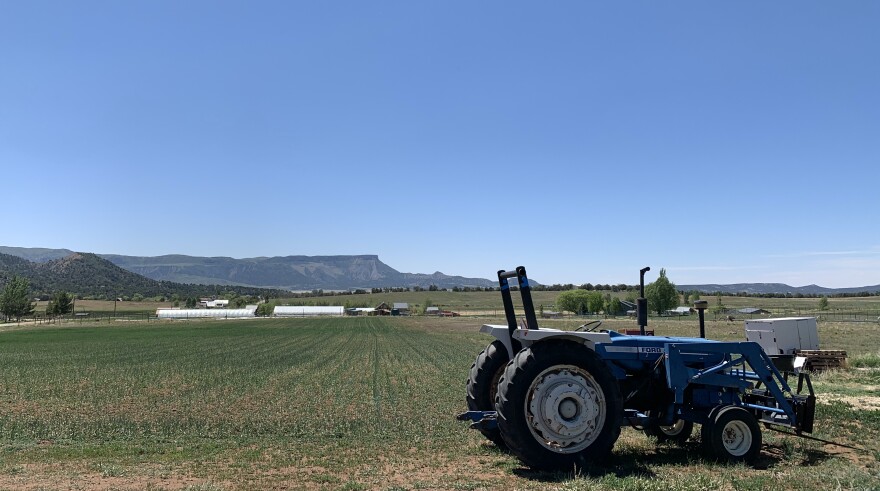When looking at professions in Montezuma County, farmers are the second most likely group to die by suicide. That’s according to data from Celebrating Healthy Communities, a Durango-based suicide prevention organization. That data also shows a correlation between drought conditions and suicide among the region’s farmers. And although mental health awareness in the ag community is growing, resources to address mental health issues are still inaccessible for many farmers. KSJD’s Lucas Brady Woods reports.
Mike Nolan has been a farmer for about eighteen years.
“I don't like gardening,” he says with a chuckle. “I like farming in the sense of, I like tractors, I like equipment. I like big harvests.”
His farm is in the Mancos Valley. It sits at the base of the snow-capped San Juan Mountains and across the valley from the bluffs of Mesa Verde National Park. In a normal season, Nolan cultivates up to seven acres of crops. Anything from turnips to squash to tomatoes.
This season, though, he’s had to cut his crops down to less than a single acre.
“These fields should be cultivated and prepped and looking good, but they're covered in grass and thistle and stuff like that,” Nolan says as he points at one of his fields, covered with weeds.

That’s because the Mancos Valley and the rest of Montezuma County is experiencing severe drought conditions, which is hugely limiting water supplies for farmers.
For example, alfalfa farmers ideally need 30 inches of water per acre, per season for their crops. This season, some farmers in the county are only getting a fraction of one inch, according to the Dolores Water Conservancy District, one of the groups in charge of distributing water in Montezuma County.
In fact, the entire county is at the highest or second highest level of drought on the US Drought Monitor’s scale. And cutting crops is just one of many adjustments that Nolan’s had to make due to drought. And he says some sacrifices are harder than others, like laying off all of his employees.
“The big one was laying off everybody,” he says. “Which was a real bummer. Never had to do that. It was really hard to do.”
Nolan says that when he went through his budget earlier this year, there just wasn’t any way he was going to make enough profit this season to pay them. And he says, these sacrifices can be really hard on farmers’ mental health.
“Sometimes you look in the mirror and you're like, should I be doing this?” Nolan says. “Like, does this make any sense? That stuff, just builds. And it's in seasons like this, it can crack. And that's the scary part.”

He’s not the only one noticing the mental health effects that drought is having on farmers. According to data compiled by Celebrating Healthy Communities, which is a Durango-based suicide-prevention organization, farmers and ag workers are the second-highest at-risk population in Montezuma County. That means they’re more likely to die by suicide than almost any other group.
But that’s not everything the organization’s data showed.
Celebrating Healthy Communities also compared the state of Colorado’s drought data for the past decade with the state’s suicide data for the same period. And that showed that, when drought conditions increase, so does the suicide rate among farmers.
JC Carrica, the CEO of Southeast Health, isn’t surprised by those findings. He specializes in behavioral healthcare in rural communities and leads a program called The Coffee Break Project, which promotes suicide awareness and prevention among farmers and ranchers.
He says, because farming is a volatile business in the first place, some stress is natural.
“There's seasonality,” he says. “There's peaks of anxiety, peaks of depression. It's ever flowing, much of which is beyond their control, because it's weather related or market volatility.”
He also says drought can be especially devastating.
“When you see the wind come through and shear off whatever little bit of grass you had from a quarter inch or rain a couple of days prior,” he says. “It's kind of the carrot and the stick and sometimes there’s just not enough carrot to keep people's hopes high.”
He also says other factors contribute to mental health issues among farmers, including unpredictable markets and generational differences among family members. And the issues are compounded because most mental health services are simply not reaching farmers.
According to Carrica, one obstacle is that farmers often live in areas that are remote and sometimes lack internet connectivity. That limits their ability to participate in remote healthcare and to find mental healthcare providers in the first place. Carrica also says that most existing mental health services simply don’t meet farmers’ needs.
“You have to understand what's important in people's lives and what those vulnerabilities are, so you can help them talk about it,” he says. “And if you miss that one opportunity that one time they came in, that one time they had the courage, it may be the only shot you got, the only time they try it.”
He says the answer is to make more of an effort to get services to farmers, on their level.
“We can start to create more access points,” he says. “And people will feel like treatment is more palatable, and not as scary for them.”
Kate Greenberg is the Commissioner of Agriculture for the state of Colorado. Like Corrica, Greenberg also says that farmers have struggled with mental health historically because of the volatile nature of their work.
“When it comes to drought and the intersection of drought with mental health,” she says, “The stress is just a baseline stress on agriculture. You get one shot a season, at least in the Colorado climate, to get a crop in and out of the ground.”
And if that one chance doesn’t work out, it affects a farmer’s bottom line.
“As we see financial stress increase, as we’ve seen, in the last decade or so,” she says. “We also see spikes in suicide rates among agricultural communities.”
Greenberg also agrees that the more local the resources, the better.
“That's where the relationships are,” she says. “And that's where the the knowledge of culture and culture is that reside in that region, and the particular stressors there.”
And she says the state is working with various local partners to facilitate local resources. She also says there has been work done over the years on the state level to provide mental health resources like downloadable toolkits for mental health providers or public service announcements. One of those efforts is the Colorado Crisis Hotline, which is a free and confidential mental health resource that’s available 24/7.
But Greenberg also says there’s another disturbing trend. Colorado is seeing progressively fewer farmers and less farmland as the years go by. Greenberg says this is due to a number of issues, but that water will continue to become more and more of a challenge for farmers to stay in business.
The Colorado Crisis hotline can be reached at (844) 493-8255 or via coloradocrisisservices.org.
Health and prevention reporting on KSJD is made possible by support from Celebrating Healthy Communities, the Montezuma County Health Department and Southwest Health System.







